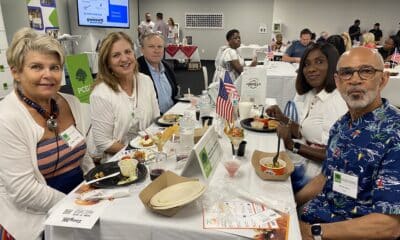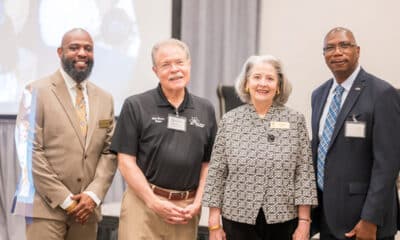Business
How did Brightree Successfully Work with Clients and Manage Employees During COVID-19
Published
4 years agoon
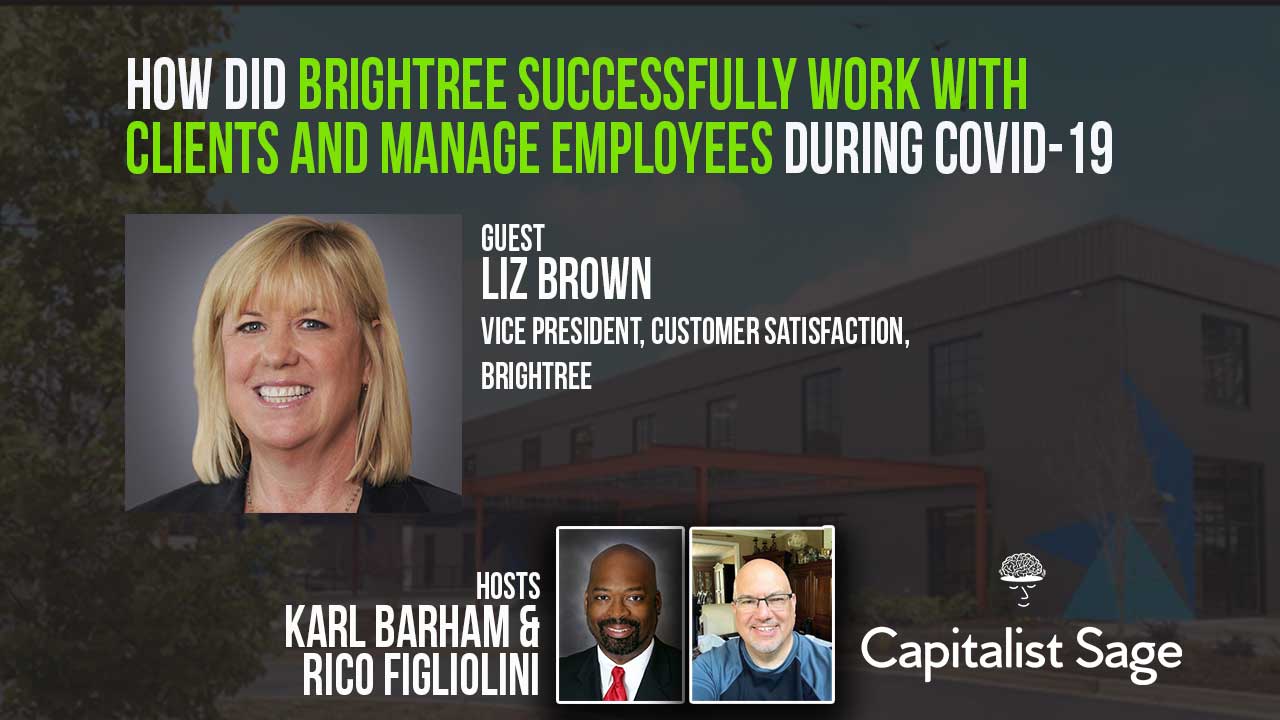
How did Brightree respond successfully to the pandemic, how did they meet urgent customer needs and what initiatives did they put in place to support employees during this time? Brightree’s Liz Brown joins hosts Karl Barham and Rico Figliolini to discuss this and more. Recorded socially safe in the City of Peachtree Corners, Georgia
Resources:
Website: https://www.brightree.com
Timestamp:
[00:00:30] – Intro
[00:02:27] – About Liz and Brightree
[00:03:38] – Initial Response to COVID
[00:05:54] – Employees Working from Home
[00:08:22] – Productivity of Employees
[00:10:24] – Adjustments on the Customer Side
[00:14:49] – Working Through the Summer
[00:18:02] – A New Hiring Process
[00:20:35] – Helping Customers
[00:23:15] – Leaders in Brightree
[00:25:27] – Going Back to the Building
[00:28:02] – Long Term Changes
[00:30:11] – Closing
Prodcast Transcript
Karl: [00:00:30] Welcome to the Capitalist Sage Podcast. We’re here to bring you advice and tips from seasoned pros and experts to help you improve your business. I’m Karl Barham with Transworld Business Advisors, and my co-host is Rico Figliolini with Mighty Rockets Digital Marketing, and the publisher of the Peachtree Corner Magazine. Hey Rico, how are you doing today?
Rico: [00:00:50] Good Karl, how are you?
Karl: [00:00:51] Doing well, doing well. Why don’t you introduce our sponsor for today?
Rico: [00:00:57] Sure. Our lead sponsor is Hargray Fiber. They are a company in the Southeast that provides fiber optic technology and solutions that legacy companies and small businesses can use to be able to do the work that they do out there. They’re involved in the community and they are definitely out there. And they’re not the cable guy. So if you’re looking for fast internet connection, look for a company that can support you, not only in your office and your business, but also your employers that are working off site. Hargray Fiber is the company to go to. So visit HargrayFiber.com/Business, and there’ll be able to work with you. Thanks to them for being our lead sponsor. And I’m going to be playing engineer today. We’re going to let Karl and our special guest today work the half hour of Capitalist Sage.
Karl: [00:01:49] Sounds good. Thank you, Rico. Thank you to Hargray Fiber for continuing supporting both the Capitalist Sage and the community throughout Peachtree Corners. Today it is my honor to have a guest on that can help talk a little bit about her experience and her company’s experience over the past few months as we’ve dealt with this pandemic. Liz Brown is the vice president of customer satisfaction at Brightree, a local software company located right here in Peachtree Corners in Atlanta Tech Park. Liz, how are you doing today?
Liz: [00:02:25] I’m doing great Karl. How are you? Thanks.
Karl: [00:02:27] I’m doing fabulous, thank you so much. Why don’t you tell us a little bit about yourself and a little bit about what Brightree does?
Liz: [00:02:35] Sure. At Brightree we’re focused on technology innovation, and we ensure that we provide a stimulating, supportive place for our team members to work while helping our customers run better businesses as they deliver high quality patient care. So we’re actually an industry leading cloud-based healthcare IT company. We provide solutions and services for thousands of out of hospital care providers. And we just recently located our headquarters to Technology Park in Peachtree Corners, December of last year. And with that move, we reinforced our commitment to innovation and collaboration amongst our team. In light of this year’s events, we’re proud of how we’ve executed on that commitment and ways that we’ve helped us keep Brightree a fulfilling, supportive, and stimulating place to work while providing opportunities for local collaborations. So at Brightree, my title is vice president of customer satisfaction. I manage our implementation and customer support teams. But I also lead our facilities teams and we developed a pandemic response plan for Brightree earlier this year.
Karl: [00:03:38] So I’m curious to ask, when the pandemic started, what was your response and your feelings about it and how did you approach it? You and Brightree approach responding to some of the challenges the pandemic brought?
Liz: [00:03:53] So first and foremost, our priority was, and has always been the health, safety, and wellbeing of our employees. We needed to figure out how we could ensure their safety while continuing to keep our customers operational during the time when care and services for our customers was arguably the most important thing ever. So to address it, we really quickly transitioned to work from home, in almost four days actually, and implemented new work streams and strategies that would help our employees excel in the working from home, but also keep the continue of customer support up and running. So some of the things we did, so for example, our executive team started daily huddles on the very first day. And we added in the site leaders from our remote offices to ensure there was an open line of communication as we rolled out our pandemic response plan across Brightree. We use these meetings to raise barriers or concerns that came from the employees. We had employees, for example, who didn’t have internet at home, and we needed to address that. But we also used it to address any concerns that might’ve come from our customers so that we could tackle them swiftly and promptly. And it was from these daily huddles that we have the executive team. We also established an employee engagement team. So we pulled together a group of 20 employees across the company, one representing each department. And they worked with me and our people team leader really closely to provide sort of real-time insight and the pulse what was going on in the day to day amongst the team. And we met with these folks twice monthly and made sure that our pandemic plan that we had in place was working for them, but also that they were engaging with the rest of the organization. So we could get that real-time feedback and direct path right back to the executive team, where there might be areas that we had to address for health, safety, and wellbeing. And we encourage those employee engagement team members to collaborate and create collaboration events with their team. As we all transitioned to working from home.
Karl: [00:05:54] Can I ask a question about, as employees transition to working from home, the informal interactions that people had in the office, what were ways that you were able to help at least close the gap from that, just, you know, working together, the huddles around the coffee. Are there things that you’re able to do to help with that?
Liz: [00:06:17] Yeah, so we did, we established sort of some fun events. So first off we established office hours. So utilizing zoom, which we all had to adapt to, we opened up office hours on Friday afternoon from one to five, and it was an open zoom where people could really just drop in. Like you would’ve dropped in before you might’ve walked by somebody at the coffee machine. You might’ve walked by somebody in the hub getting, you know, a glass of water. Now you just dropped in and everybody knew it was open. So that they could just engage with each other. Over time those became more, a little bit more formal and more fun. So there were happy hours. There were wine tastings and people came up with ways to engage with
each other from home over zoom, of course. But it did sort of try to mimic that whole drop by, how are you kind of thing.
Karl: [00:07:05] Another follow up question on the employee side is, as people had to deal with childcare at home and different work environment, the remote schooling and all of that, were there things that you found people innovated and came up with to navigate the new norms that was happening throughout, you know, March, April, May when this first started?
Liz: [00:07:28] Yeah. And, I’ll tell you, so you know, the wellbeing of the employees was one of the most, was forefront in all our decisions in how we operated and, you know, being that we’re a customer facing organization, what we did is gave the employees the opportunity to manage their workday. So to your point, people with middle-school children had to figure out how to help them get on Zoom to make sure they could get their homework done. But then there were people who were having to adapt to childcare and eldercare and how could they get that done and also get their work done during the day. So we gave them the opportunity to set their work hours so they could adapt both managing their wellbeing from a work perspective, but then also keep those commitments they had to their family. And I think that worked well because when they had those, you know, flexible work hours and were able to adjust their schedule, they could feel like they could balance and get everything done during the day.
Karl: [00:08:22] One of the great things I thought that I saw happening and your, Brightree is a great example of this, companies, corporations had dabbled in this for years. Employee suggestion boxes, they’ve done an install. What the COVID pandemic did, it kind of forced us to make a decisive action, to help people be more able to work and operate from home environments, flexible work schedule. There was always the critique of it in the past that you couldn’t get the same productivity out of your employees, if you let them have more freedom and flexibility, but we were forced into it unfortunately this year. How have you seen the productivity impact on employees during this pandemic? Especially after that first initial wave where we were all in shock of course, but how did it normalize?
Liz: [00:09:14] So I will tell you this, it’s one of the things we’re most proud of the entire Brightree team is our productivity has really been consistent from the day we moved home until today. So yes, we do manage our organization by KPIs and metrics, and we haven’t seen those falter and I think it was providing the employees the flexibility in their schedule. And being able to give them that opportunity to have that wellbeing and being able to take care of themselves and their family, that they were able to maintain the productivity. And we also haven’t seen any dips from a customer satisfaction perspective. You know, we’ve been very consistent. We do use the net promoter score, NPS scoring with our customers, and it’s been extremely consistent since March. So I think by putting the employee safety, health, and wellbeing, first and foremost, you know, I run a customer support organization and I always say, happy employees makes happy customers. And we tried to follow that mantra as we moved to working from home so that everyone felt, you know, not only safe, but they could work and do what they needed to do in the time that they could do it and be productive for the company.
Karl: [00:10:24] So you’re in an interesting industry in space where, a lot of your clients and customers are in the healthcare and healthcare based businesses. And this pandemic, we all know absolutely hit right smack dab into that part of our economy. What were some of the things you have to do to adjust on your customer side, your customer facing interfaces, to adapt to this pandemic year?
Liz: [00:10:50] So, the same way we sort of went right at it from an employee perspective, we out of the gate do the same thing with our product management team on the customer side. So we very quickly engaged with our customers. One-on-one conversations with the salespeople had. We also held, peer to peer community groups. We also engage with our customers through coffee talks and we very quickly, you know, we established by a mantra that we use, which was ask, listen, act. And we used it both for our customers and employees. So in the very beginning, from a customer perspective, we were asking a lot of questions. You know, examples might include how are they getting PPE? Because our customers needed to have PPE, you know, and were they able to get PPE? And we actually had forums in which customers in certain cities were sharing with each other, you know, best practices around how they were actually acquiring PPE, which we all know was in a shortage in the beginning and giving each other resources.
But what we did from a Brightree perspective, sort of after asking is then we sort of hit it from a product perspective. We are a product technology company and we very quickly rolled out product updates so that we could support them as customers. That was everything from COVID 19 diagnosis codes, giving them the ability to confirm a delivery with a photo instead of a signature to enable social distancing. We developed a COVID 19 impact analytics dashboard, which we made available to our customers at no charge. So they could get a better understanding of their operational and financial standing amid the pandemic. And we also created, as I said, forums. So they could engage with each other. Sometimes, you know, our customers learn a lot from each other, especially ones that were regionally situated. And from that, we were able to support them both through our community, but also through other customers.
Karl: [00:12:46] I think you highlighted a couple of things there that was really insightful for first small business owners or large business owners in when dealing with an emergency or a shock to the system in the way that we had to this year, but that interactions and leveraging your touch points with your customers. Can you tell me a little bit more about those forums? When you couldn’t get people together physically, how did you use technology and the tools that we have today to create a safe and friendly environment for customers to communicate with you?
Liz: [00:13:21] So within the Brightree product itself, we have an online community. A community forum on which customers can engage with each other. And we had a lot of information that we could share with the customers. And then the customers were able to share with each other. So first and foremost, we very quickly got out in the community forum the necessary information they needed to be able to respond to the pandemic and continue patient care. But then we also added some engagement activities. So we had coffee talk webinars where customers came together themselves, a customer would come and they would talk about a key issue or strategy that they were working on. We also have an executive advisory board,
which is made up of 15 to 20 key customers that we engage with usually twice a year. And we started engaging with them once a month, you know, Zoom being our platform. But we brought them together to understand, you know, what their evolving needs were so then we could feed the rest of the customer base. And we found that through engaging either through the coffee talks, through the EAB, or sales going back on one-on-one conversations, we’re able to engage with the customers, understand their evolving needs, and then very quickly be able to act against those and meet them, whether it’s through a product or a service or just some level of support. Sometimes we had to find resources for them that they needed to be able to service their patients. And we were able to make that happen for them through the community.
Karl: [00:14:49] I love the blended methods and I think one of the key takeaways from that is, no matter the size of your business, varying the ways that you facilitate two way communication, not just one way, but through the advisory board, you’re getting feedback on tough topics.
You’re doing it in informal settings, and then you’re leveraging your sales team and your account management teams. They have one-on-one conversation in multiple ways. I think very often small business owners, they’ve fallen in love with social media in a way of blasting out one directional information. But this year showed where creating a community forum where people can facilitate two-way communication can happen in the digital way, as well as the old fashioned pick up a phone or today a Zoom and get online and have face to face or real conversations with people. That’s very, very wise approach to do that. And you can probably see some success with that. I’m curious, I wonder, from a business standpoint as you started going through the summer, a lot of businesses were stuck in neutral if you’d call it during the pandemic. How was it for you in continuing to execute the plan you walked into the year with?
Whether it’s on hiring, whether it’s on market share. Were you able to continue to grow and
execute throughout the pandemic?
Liz: [00:16:23] So on both fronts, we were extremely fortunate. So from a hiring perspective, we actually were able to hire throughout the pandemic. Absolutely. And we even had our intern program this summer, which I know is quite unique. So we were able to bring in remote interns. So they got the opportunity to do work in a remote environment. We brought those in, in our marketing and sales team. And, you know, we all had to figure out how to be agile and find new ways to support the new hires in our environment, in this in-home dynamic. And we did that. As part of our onboarding process, we put in place a mentor program. So when you think of a mentor, sometimes people think of it as your boss. And we actually took a different approach.
We asked the hiring manager to pick someone who would be that person they could go to, to ask questions that you don’t normally want your boss to know you don’t know the answer to. But somebody in this remote time that can sort of steer them through the halls. Even though they were virtual halls, right. That they could, you know, very quickly reach out to on teams because they’re in a meeting and they don’t know who this person is that they’re, you know, somebody who’s asking questions, so they don’t know what is. But somebody who’s just there for them all the time as if they were there in the office. So we had to try to figure out how to simulate that environment from an onboarding perspective. So yes, we were very grateful and very thankful that we continued to hire. And actually from a business perspective, we were extremely busy.
Our customers were very busy and we were very busy along with them and from a business and
financial perspective, we’ve done quite well. Yes, we were able to grow through the pandemic and very appreciative of that.
Karl: [00:18:02] That’s fabulous. To hear what, to hear another company that’s, you know, faced with a crisis, still figured out how to pivot on, how do adapt quickly and that’s one of the things that great companies often are able to do. I am curious about, as you were talking about hiring through that, I remember a time when the hiring process involved, someone coming in having an interview with 12 people on a team for a full day and then they go home. And so there was an element and a premium put on for hiring managers and teams to see the person, they were looking for certain things. How has 2020 change people’s thinking on what’s important in the hiring process, interviewing. And were you able to do anything to change that process that you think you might want to keep even beyond this season of the pandemic?
Liz: [00:19:05] To be honest, we actually have, we initiated a process with our parent company Resmed, gosh, probably six months ago. We actually utilize a product called Hire View. So as part of the original, as part of the first level of hiring, the hiring manager provides questions to the recruiter. And the actual applicant has to, through Hire View, which is a zoom like product, present the answers to those questions, right? So you sort of get that in-person feel, the hiring manager gets before the interview process even started. And once they pass through the hire review, Then we’ve been using a team interview process in person for all of our interviews. So we’ve started to use that as a best practice across the company. Where we bring in, let’s say for example, in my area professional services, we’re hiring a new manager and that new manager, once they’re on board is going to work with a lot of different departments in the company. So I select a person from each one of those departments and they work on a team interview and each person has a role and responsibility on that interview and they participate as a team. So we learned, and we figured out when we moved to working from home, we could do the same exact process with Zoom. And it worked just as well. So the interview candidate was still engaging with all the same people that they would have if it was in person. And we found actually it worked quite well. So it was, that was a good, best practice. And we’ll continue to use it if, you know, at some point in time, hopefully here very soon we’ll use it in person. And if not, we’ll continue to use it virtually.
Karl: [00:20:35] I’m curious if you follow that same thinking with your customers. I’m sure when you’ve, find acquiring customer there’s some process of onboarding them, especially if you’re implementing technology. How have you adapted, based on the social distancing constraints where you might’ve walked in and jumped on someone’s computer, are there things that you were able to figure out to help with that part?
Liz: [00:20:59] Yes. And that was one of the first things that actually my department in professional services had to adapt to very quickly. So one of the first things we do when we onboard a new customer is we go onsite and we do an operational workflow analysis and design. So we had to really quickly pivot and determine, you know, figure out how are we going to now do that remotely. Because what we’re doing is we’re going in and talking with all the key business leaders about how they, in a future state, want to utilize our technology. And it’s very
much a sort of in-person engagement. And in the March, April, May timeframe, you know, really through the summer, that was not something that we were equipped to do, nor was our customer. So we needed to create a virtual environment in which to do that. And those went very well. But I will tell you, as we went through the rest of the implementation, there was a point in time where the customer said, this has all been great, but now we all need to get together. So we had to figure out how to do that. And I will tell you, starting about a month, month and a half ago, we started to do it. We have a very specific protocol and policy and we need to work very closely with the customer. So that, for example, you know, from a social distancing perspective, when our consultant goes in that they’re able to meet the requirements that we put in place, because again, the health, safety, and wellbeing of our employee was most important. First and foremost, the employee had to volunteer. There was no asking anyone to go. They had to totally volunteer. And because, you know, our consultants are road warriors. They’ve been home for quite a while. So we had a few volunteers very quickly, but they were very appreciative of, we put in place our own pandemic guidelines for in-person meetings. And we had to ask the customer to abide by that same protocol. Now, being that a lot of our, you know, our customers do patient care, so they’re also in healthcare. They very much appreciated it. So I would tell you, in the last two months, we’ve probably done six of those. And they were very important because they were that end of the process for the customer coming up on our technology and they needed that in-person contact. But it’s, you know, ensuring the health, the wellbeing and the safety of the employee was as important as for the customer.
Karl: [00:23:15] I think one of the things that’s becoming really apparent in my conversation with you today is to implement all these things. When I know sitting in January of 2020, most of the world would not have realized what had happened. It takes really strong leadership to do that. What’s some things about Brightree that makes its leaders able to respond the way that it did this year?
Liz: [00:23:44] You know what I would say, we’re extremely agile and we’re extremely adaptive. We’ve got an excellent executive team. We all work very well together. We’re all very strong leaders in our own domain. And you know, we care about our employees and we care about our customers, right. So we came to it, you know, I know I keep saying it, health, wellbeing, and safety. But it wasn’t only for us, but it was also to ensure our customers can continue doing what they needed to do, which was provide patient care. So, you know, the Brightree executive team, we handle a challenge very well. We’re extremely adaptive and we did turn on a dime. We literally turned on days. And we sent everybody home and we had our policies and procedures in place. Because you’re right. In January, imagine we had just been our office for 30 days. We were all so excited. We’re in Peachtree Corners, we’re in a brand new building. We have this extremely beautiful building, great collaboration area. We’re all so excited. I mean, everybody was really pumped. It brought new energy to the company. And then with, you know, unbeknownst to us in three months, the whole world’s going to change. But I will say we brought that energy home, not to say there wasn’t in the month of March, you know, a total assimilation. You know, everybody at home now, like, you know, your routines totally changed. Your workdays totally changed. But we put forth the effort because we knew our customers were doing direct patient care. And everybody was looking at the news and everybody didn’t know
exactly what was going on. So we needed to continue to do what we needed to do and be strong, you know, stay strong as one of our mantras. And we did that for not only our employees, but also, you know, for our parent company Resmed and our customers.
Karl: [00:25:27] So with the beautiful building that’s been right here in Atlanta Tech Park, have you begun to think through the strategy with the vaccine, multiple vaccines on its way? How you start thinking about bringing people back into the building? And what are some of the things you might keep from this year going forward? And what are some of the things that you definitely want to get the team back together in the building?
Liz: [00:25:50] We actually already started coming back. So, I guess it was about a month ago we, you know, there’s a portion of our employee base that really would prefer to work in the office. So we have a very, you know, we have a very large office, but we set, we did a very soft open and set the opening at 25 people at a time. And one of the first things that we needed to do was figure out, you know, again, how can we do this safely? And we know that there was some mainstays that had to be there, social distancing, you know, health checks, you know, how are we going to make sure that somebody who’s coming into the office should be in the office? How are we gonna know who’s in the office and when they’re in the office? And if in fact we ever had an issue from a COVID perspective, how could we do contact tracing? So we partnered and actually bought a new technology from a company based in Alpharetta. I love that it was local called Mathtitian and they gave us the ability to implement the solution that gave really all the facets that we needed. So for example, today, if an employee needs to go in, they schedule themselves and they schedule when they’re in the office, they’re sent through the technology, either SMS or an email, a prescreen health at a station that they need to do before they can come in. And once they’re approved, then we know where they are. So we can schedule them, they can do their pre-screen. But then we also that enabled contact tracing for us. And then by working with Mathtitian, we could develop our floor plans so we knew we had physical distancing. Whether it’s, you know, these two people sit in and the workstation is at least six feet apart. Or if there’s a group that wants to go in a conference room in which seats would they sit, so we make sure there’s physical distancing there also. So we’ve started that process. Like I said, it started a month ago and it’s been going well. You know, we’ll see as time goes on and as the months go on, one of the important factors, you know, we look at is health and safety. So we’re checking the metrics and we know what the metrics are for the Atlanta area, for the Gwinnett County and Peachtree Corners area. But we, you know, keeping that employee safety is the primary goal. We’ll continue to evolve the plan as time goes on.
Karl: [00:28:02] Well, I tell you, all the things that Brightree’s done now going to help their employees adapt of customers, figure out how to be more successful through this year. I’m glad to say that, you know, we’ve got a company locally that’s leading the way in helping figure this out. It’s such a tough year. I’ve got a last question if I could ask, you know, when everything that went through this year, both professionally and personally, that most people have gone through, is there something that you implemented or did this year that might’ve been caused by the pandemic that you think can live beyond this? When this is all said and done, and the pandemic
has gone away and we’re all vaccinated. Are there things in the business that you’ve changed that you think have a long term future within your organization?
Liz: [00:28:51] I think we’re going to look at the opportunity that we gave the employees to work from home and have that flexible work schedule and have that, you know, focus on wellbeing and balance. That will absolutely continue. I mean we’ve heard it loud and clear from a, well, we do pulse surveys with our employees every six months. And that came through loud and clear. We’ve done two already, cause we did one right after the pandemic. But, you know, reinforcing wellbeing and balance. Not that it wasn’t in the forefront of our culture before, but I believe that that will continue to be on the forefront. And then the level of communication. So I talked about in the beginning, you know, the daily huddles. We also had town halls and we had those every week for quite a few weeks. And we’ve moved now to, you know, once a month, every other week or once a month, depending on the time period. And that level of communication, maintaining that. Because that gives the, you know, the engagement level with the employees without a doubt. But I think some of the, you know, the other aspects of our culture, you know, agility and change and you know, the care that we give for both our customers and the service excellence, those will all continue. But I think we’ll look at that flexibility for the employees so that they can, you know, live their best life. And also, be the best they can be for Brightree.
Karl: [00:30:11] There was one thing that became apparent. Although this year we had to physically distance for safety, I think Brightree and your team and the rest of the organization did a great job of actually keeping people together. So I don’t know if this term social distance really meant the same. I think communicating people keep people connected. We’ve done a better job probably as a society. You definitely would put it in your business, even though people may be physically distanced you were able to shrink it a little bit and keep people at least socially connected throughout this. Which is fabulous. Well, I’d love to thank you so much for taking some time out of your busy schedule to chat with us on the Capitalist Sage. I’d like to thank Liz Brown, the vice president of customer satisfaction at Brightree right here in Peachtree Corners for your insights and sharing your experience. There’s a lot of companies that struggled through this, they implemented some of the things you’ve had. Some didn’t. But what you’ve highlighted and shared with folks that there’s a different way to think about adapting. And I know a lot of people took a turtle mentality and just kind of, you know, hunkered down. But there’s ways to find innovative ways to continue to live your mission in your organization. And thanks for sharing that with us today. I’m Karl Barham with Transworld Business Advisors of Atlanta Peachtree. Rico and I have the pleasure to talk to local business leaders and owners, here in Peachtree Corners and surrounding areas, to talk about things that can help any business owner, whether it’s a small business, a large corporation or anywhere in between. It’s really been a pleasure to share insight from folks that are having success in doing that.
Transworld is our business and we help consult. I work with small business owners when it comes time to make those important decisions in life, around exiting their business, whether it’s selling or growing through acquisition. So we are an M and A firm and business sales firm that helps people with doing that. And so you can always reach out to myself or anyone on my team to schedule a consultation. You can always find us at www.TWorld.com/AtlantaPeachtree. Rico, why don’t you tell me a little bit about what you’ve got going on over the next couple of weeks?
Rico: [00:32:31] Sure. I’ll keep it short here, but we’re working on Peachtree Corners Magazine. The next issue, Faces of Peachtree Corners is the feature story. Along with some of the things that we have in there. We just finished the photo shoot here at Atlanta Tech Park last night for that feature. So we’re doing, yeah, magazine’s coming along. We’re on deadline. We’ll be done in about two weeks and that’ll be out the first week in December to everyone. In the meantime, you can go online at LivingInPeachtreeCorners.com to find out more information. In fact, one of the stories we have on there was the internship program at Brightree and how that worked. And that was a phenomenal story I thought. It did really well. Good to see companies out there like Brightree doing that type of work too. A lot of these kids didn’t have internship opportunities after COVID started. So, not very good for some of them because they looked forward to doing it and that becomes sometimes a job entry point for these students. So good thing they were able to do that. As far as what I do, social media marketing content work, curation, video production, photography, you can find my work at MightyRockets.com or look me up on LinkedIn, Rico Figliolini or Mighty Rockets. Either way you can find me. So, and let’s not just forget our lead sponsor Hargray Fiber again, who is a major lead sponsor for not only Capitalist Sage, but the other programs that we run, the other podcasts that we do in the city. So all good. And I appreciate Liz for being with us also, for being part of the show this episode, it was really good. I learned a lot as well, so. And I apologize. Most people didn’t know when we started this, there were technical difficulties getting this off the ground, but we finally got it through and I appreciate Liz’s patience with that. Thank you Liz.
Karl: [00:34:20] Thank you Liz and everyone at the Brightree team. Have a great day.
Related

Business
The Forum Gives Sneak Peek of New Eateries and Community Spaces
Published
2 days agoon
July 24, 2024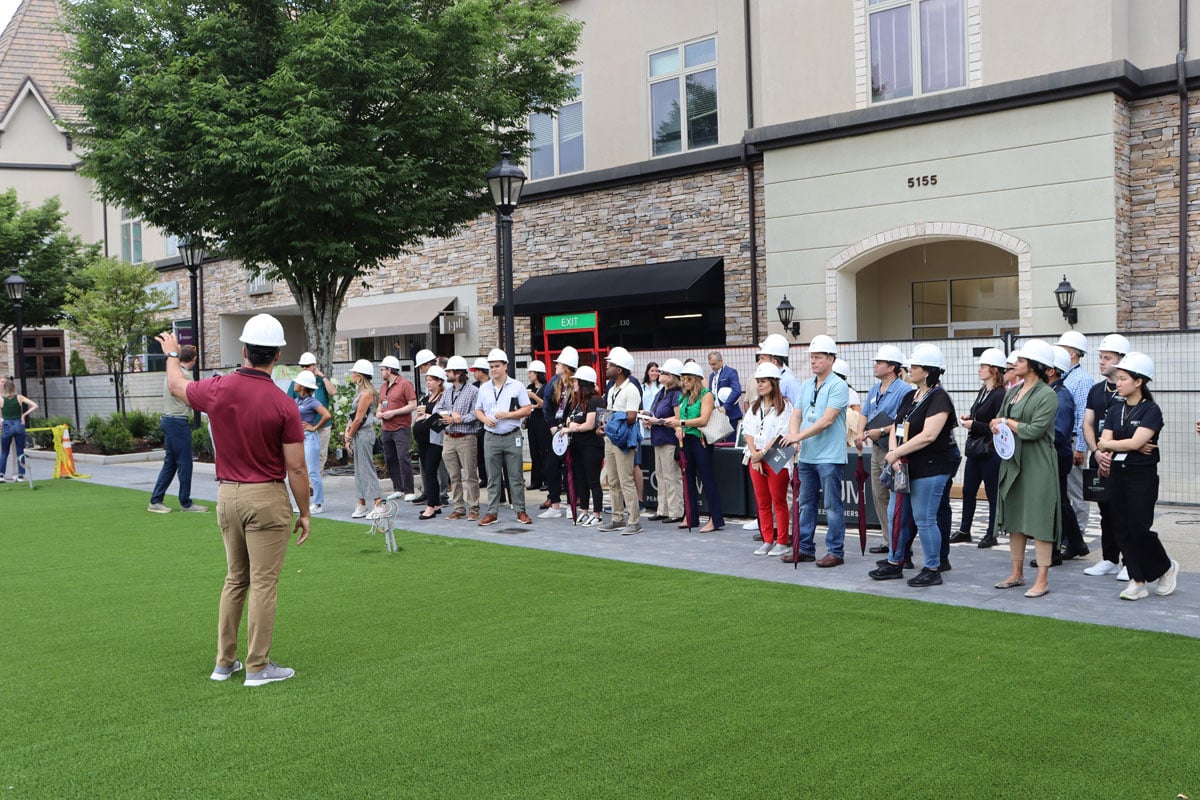
If you’ve been to or near the Forum in the past few months, you’ve probably noticed cranes and construction crews. The anticipation of the first phase of renovation of the 22-year-old retail center has left a lot of Peachtree Corners residents as well as nearby patrons excited to see changes.
The Forum administration invited the media for a hard hat tour on July 17. The event showcased the redevelopment progress ahead of The Plaza’s grand opening on Aug. 8.
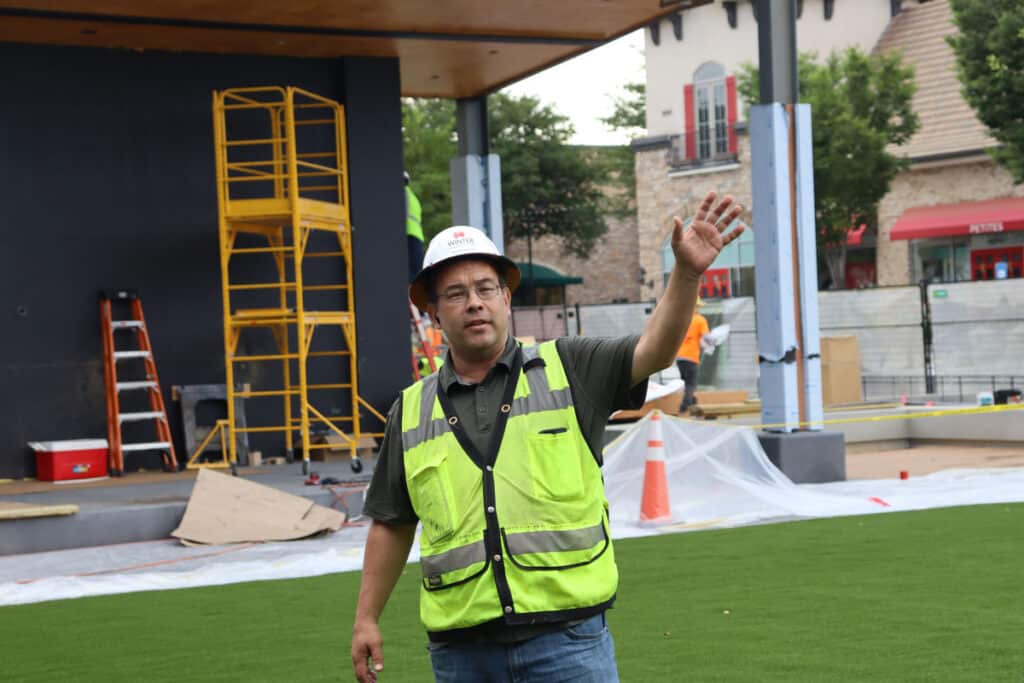
Scrumptious bites incoming
Executives from the development and leasing teams joined on-site management and led attendees around the new central gathering space, guest amenities and Politan Row, the newly created 10,000-square-foot food hall.
Dining concepts from veterans at Sheesh, Twenty-Six Thai and newbie Gekko Kitchen were the first food vendors announced for the space, which is expected to open in January.
“We can’t wait to introduce the Peachtree Corners community to our food hall experience,” said Politan Group CEO Will Donaldson in a news release. “Every detail from the design to the bar program to the cuisine is thoughtfully curated to inspire guests to not only mingle with one another but to connect with our incredible restaurateurs and discover new favorites.”
During the tour, Donaldson explained that eventually there will be seven different global cuisines in the Politan Row food court at the Forum featuring well-known and up-and-coming local talent. Once complete there will be a central bar, a private event venue and a covered outdoor patio.
“One of the things that we’re excited about is this unique design that we’ve come up with, that’s very specific to this area,” he said. “We’ll be open seven days a week for lunch and dinner. Whether you’re with a group for lunch or with your family, it works great for multiple settings.”
Twenty-six Thai owner Niki Pattharakositkul said the restaurant will work with local vendors to source the freshest meats and produce possible.
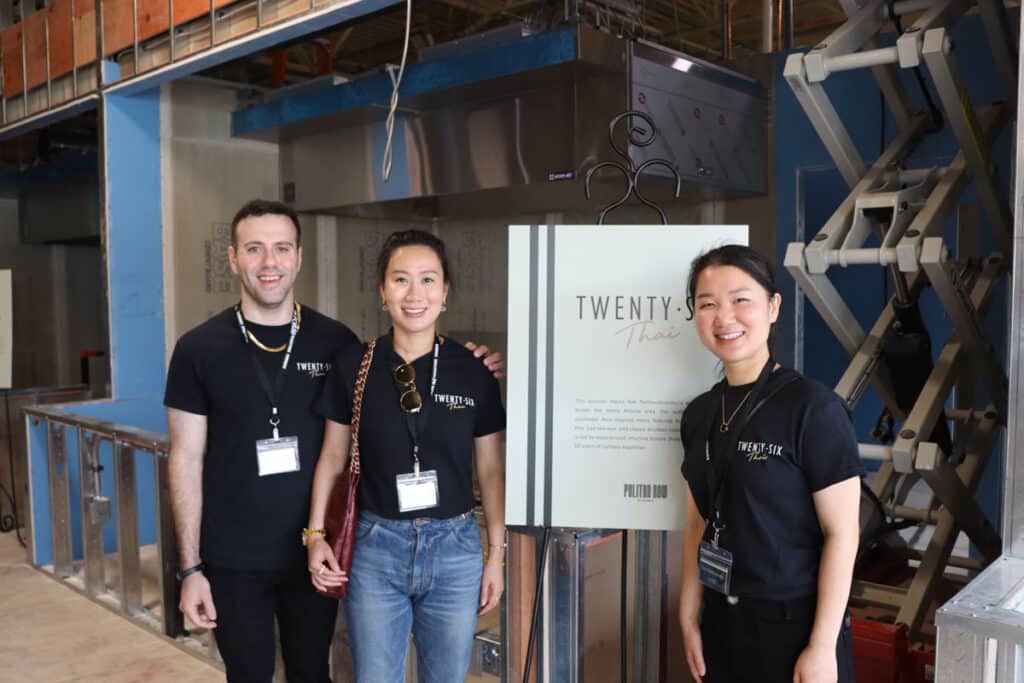
“There are certain types of produce and protein we try to source locally, but sauces and the more exotic produce and herbs, we have to import from Thailand,” she said. “Our brand is trying to move towards doing things locally and sustainably.”
Working with organizations such as Georgia Grown limits the use of large food distribution companies. Since starting Twenty-six Thai in 2016, Pattharakositkul has launched seven locations across metro Atlanta, including at Politan Row’s Ashford Lane and Colony Square.
The eatery describes itself as an “authentic wok-fired Southeast Asia-inspired menu featuring items such as pad Thai, pad see ewe and classic drunken noodles.”
Sheesh, a Mediterranean concept that uses simple, wholesome ingredients prepared with unique spices and blends, is run by corporate executive chef Charlie Sunyapong and director of operations Raquel Stalcup. The two are also members of the group behind full-service restaurants Stäge at Town Center and Pêche at the Forum.
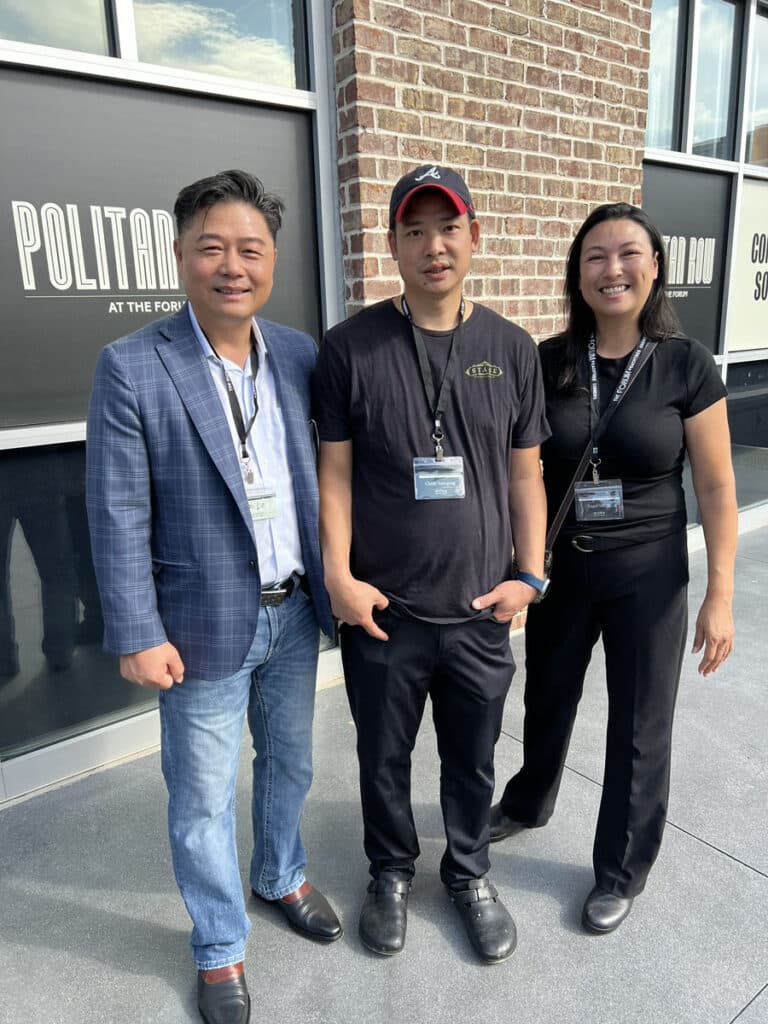
The popularity of those suburban concepts has already taken off. With Sheesh, they’re looking to do something different.
“There are going to be some things that are unique to Sheesh that you’re not going to get at the other places,” said Sunyapong. “You’re not getting a whole restaurant; this is quicker fare.”
Gekko Kitchen, a former food truck transformed into a hibachi and ramen experience, will be serving fresh, fast bowls that are more colorful and lighter than traditional hibachi fare.
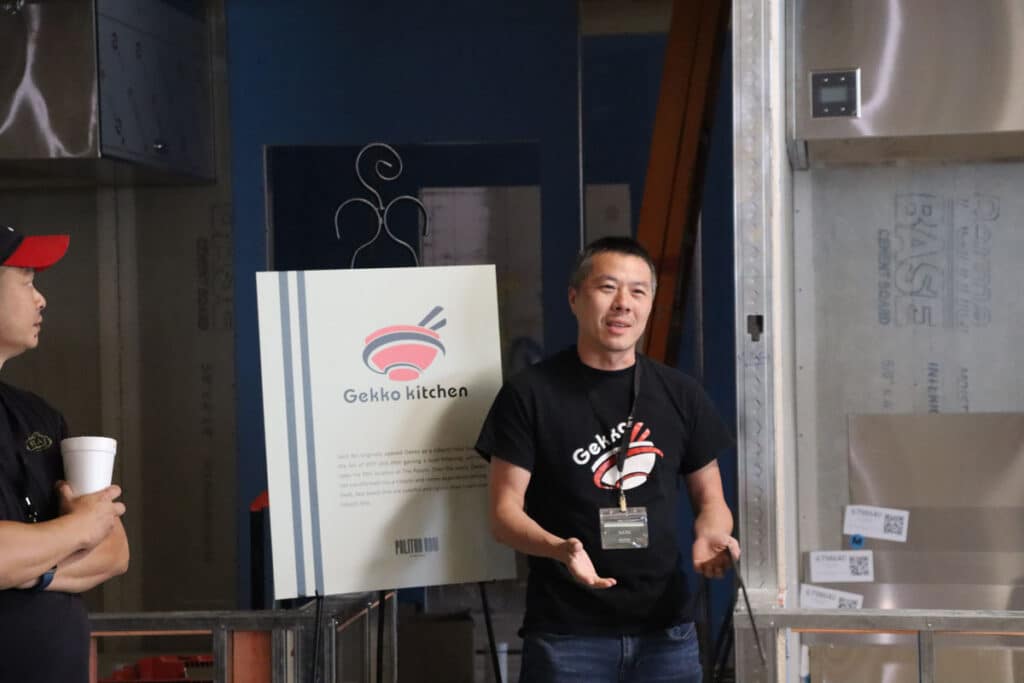
Gathering spots
Development Manager Nick Lombardo explained that NAP is moving away from building big construction projects from scratch like Colony Square in Midtown Atlanta and Avalon in Alpharetta.
“As a company, North American Properties pivoted around 2020 from building big ground-up construction to more redevelopment with already existing properties,” he said. “With the thought of great assets that just need a little more attention Infused into them to create value, we bought the Forum in 2022.”
He said that value-add propositions done at The Forum will create a more walkable center.
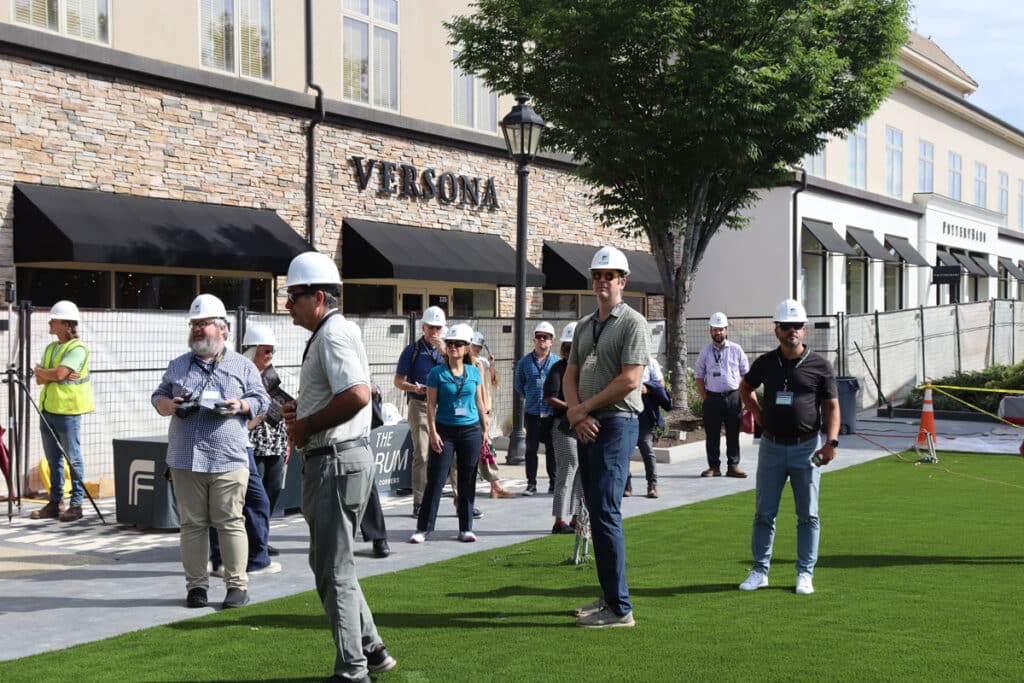
“Trying to compete with the internet on convenience is a very tough task, so the way we differentiate is by experiences,” he said. “We host between 150 to 200 events every year. We have things like concerts, wellness and fitness events and we have child playtime events. Our marketing team does a great job and they’re the differentiator when it comes to what makes our property stand out.”
By the first week of August, a large gathering space will be unveiled in the central area of the property between Pottery Barn and seafood restaurant Pêche. It will have a nine-foot LED screen capable of hosting movie nights and sports viewing. There will also be musical performances featuring local artists.
“We’re not in competition with Town Center,” said Charlotte Hinton, marketing manager at The Forum. “Town Center has gates like a real music festival and we’re more like a ‘chill and enjoy the music’ vibe where you can grab a beer and hang out or maybe kind of walk around.”
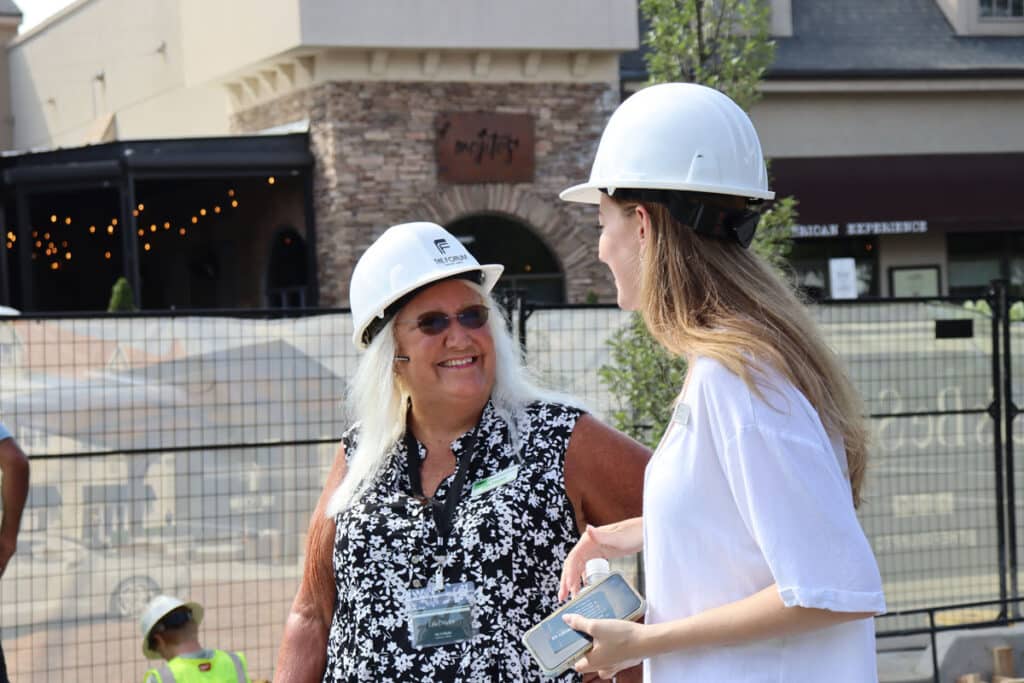
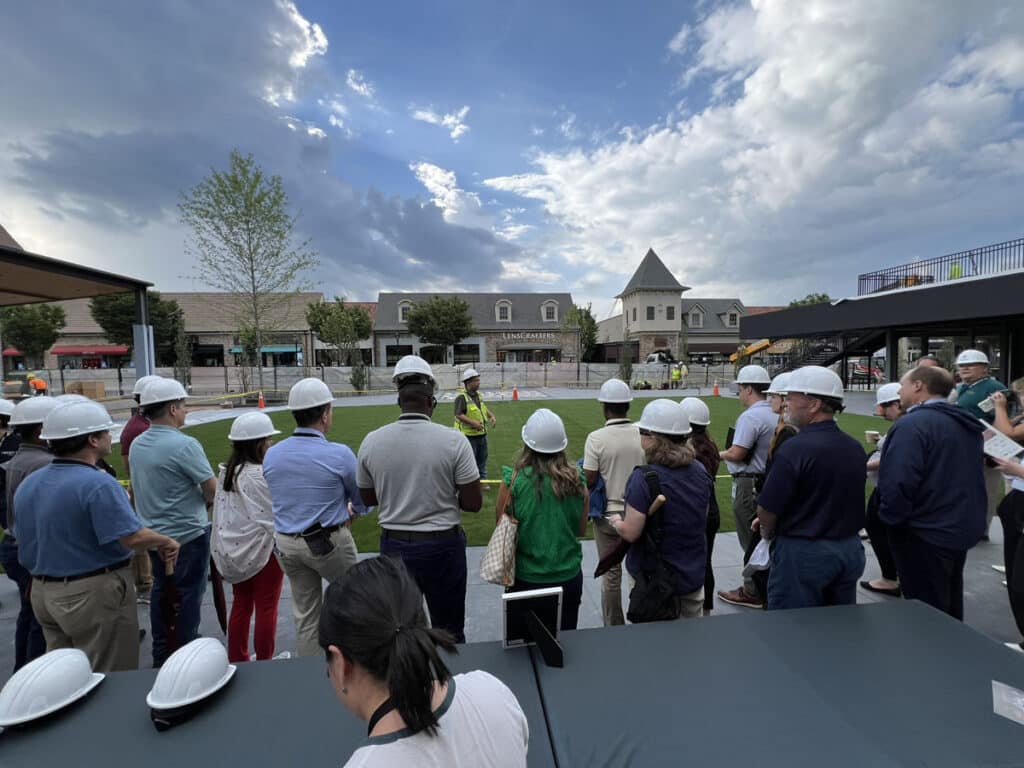
The smaller space and artificial turf are unlike the Town Center space where attendees spread blankets and bring chairs. The Forum will have furniture and seating in the space so folks can just gather and either enjoy time with family or partake in events.
The Forum will also offer valet parking on a limited schedule at that end of the property.
More improvements
Although the construction equipment will have moved out, the jewel box building will house a yet-to-be-named restaurant that will open early next year.
“We’re pretty much done with what we’re doing as far as landlord work,” said Lombardo. “We ask our tenants to bring their brand and their design and their material pallet and put that on the building to express their brand identity. They know their brand better than we do. They know how to best design their building and how it functions and works.”
It’s the same process with retail stores, he added.

“We always ask all of our new tenants to come in here when they’re building their storefront,” he said. “They’re not just selling their clothes; they’re selling a lifestyle in the brand so we ask them to push their brand out to the street.”
Even with the new spaces, there will be no shortage of parking, Lombardo added. “There’s plenty of parking behind these buildings,” he said pointing toward Pêche. “What we’ve done is enhance the connectivity to those areas. We’ve redone this breezeway and we’re adding lighting and connecting the parking lot to the main boulevard here. The goal is to replace cars with people and activity and bring a sense of community to the property.”
Related
Business
Taste of Peachtree Corners: PCBA Showcases Local Restaurants
Published
1 week agoon
July 17, 2024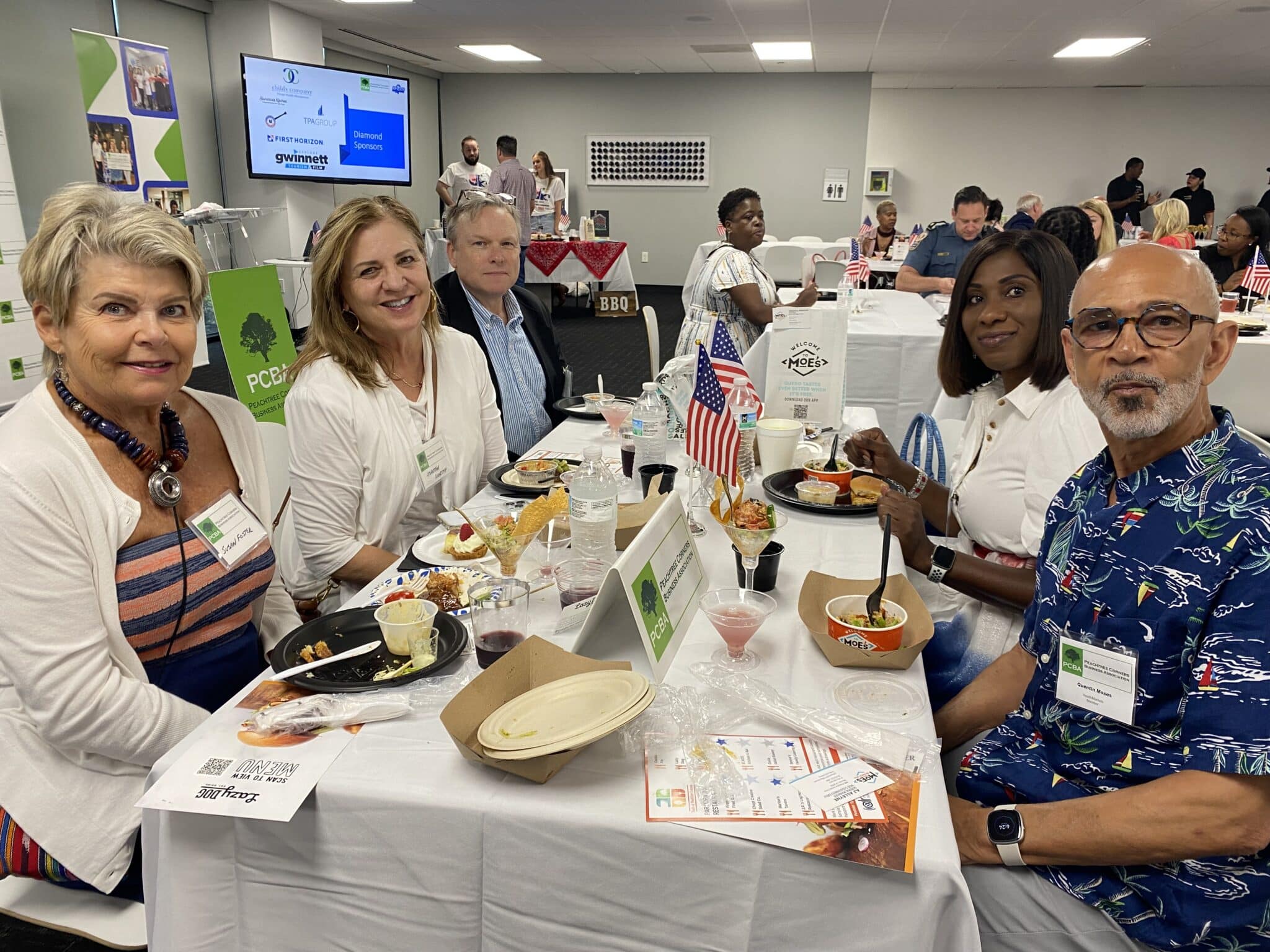
The Taste of Peachtree Corners has been in the works for years, but the COVID-19 pandemic put many key events on hold for the Peachtree Corners Business Association (PCBA).
But luckily this year, the dedicated staff of volunteers successfully executed a memorable event and introduced a lot of local business owners to their neighboring restaurants and caterers.
As I walked up to the Community Chest Room at Peachtree Corners City Hall on June 27, there was a line outside the door. I later found out that over 100 people had registered to attend the event. I got checked in quickly and was faced with a “passport” of 10 Peachtree Corners restaurants serving everything from high-end bakery items to good old-fashioned barbecue, and modern twists on seafood and American cuisines.
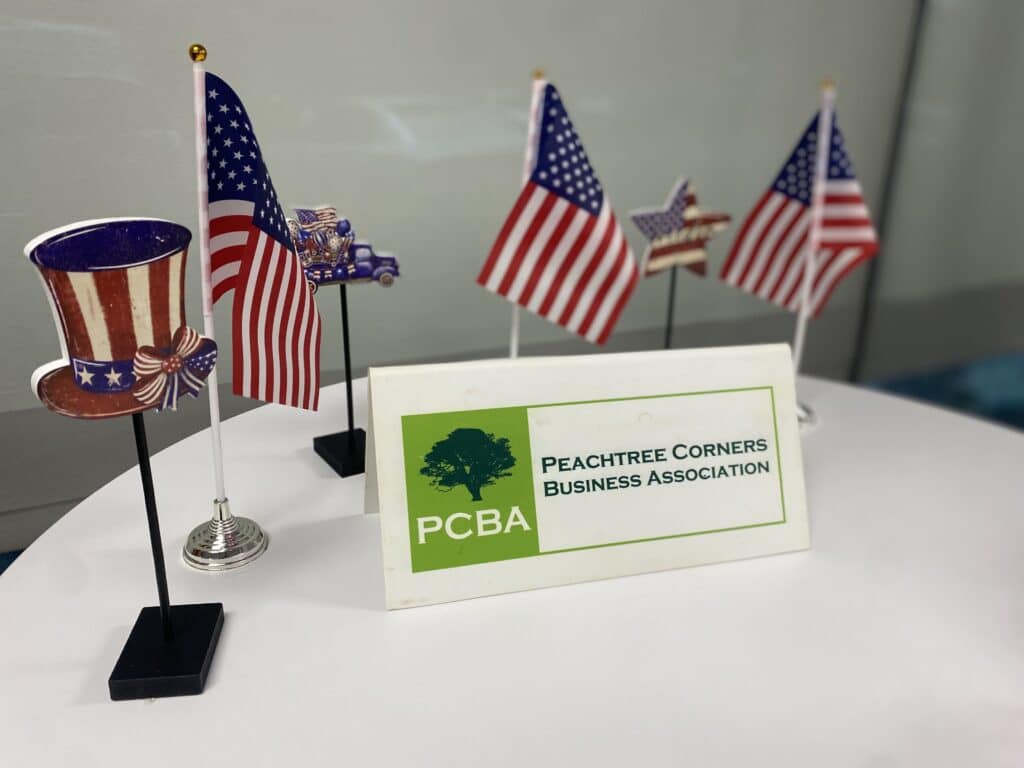
Let’s talk about the food
The idea was to visit all 10 restaurants and collect stars while trying samples and small plates. My first stop was Firebirds Wood Fired Grill, and they had my favorite – homemade chips and queso. The queso was smoky and mildly spicy with a great depth of flavor. What a great start. Next up was Chopt. Creative Salad Co. I had never heard of this restaurant before, but they blew me away with a perfect amuse-bouche of cherry tomato, pesto, mozzarella, and olive oil. These guys understand simple and fresh Mediterranean flavors.
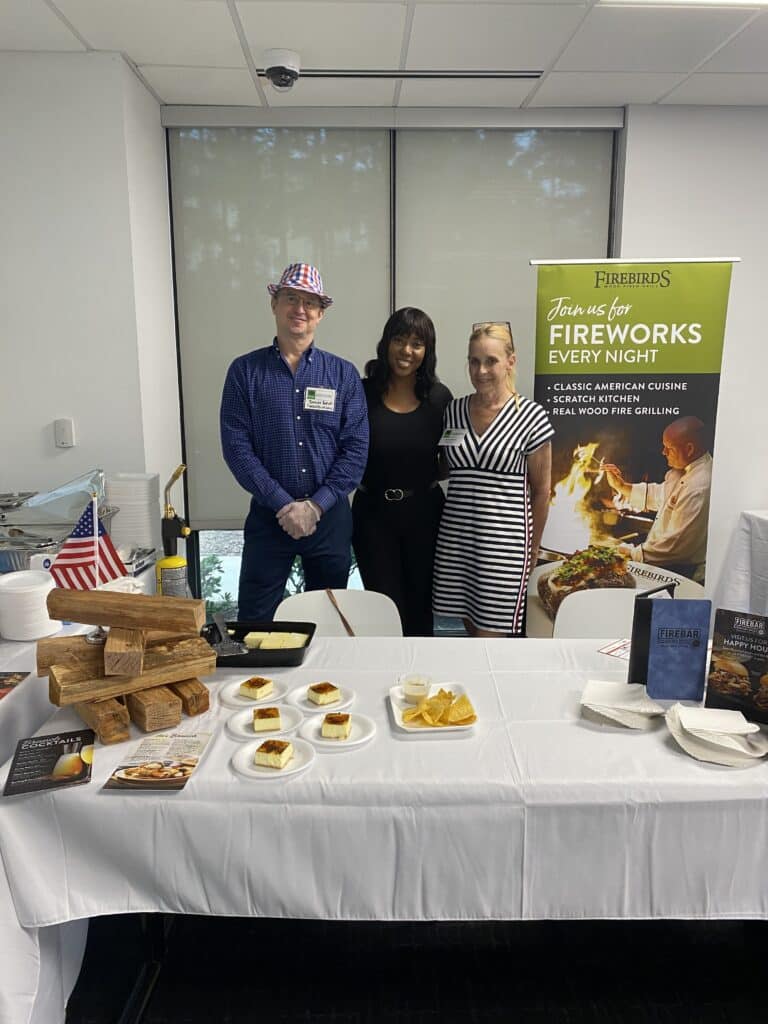
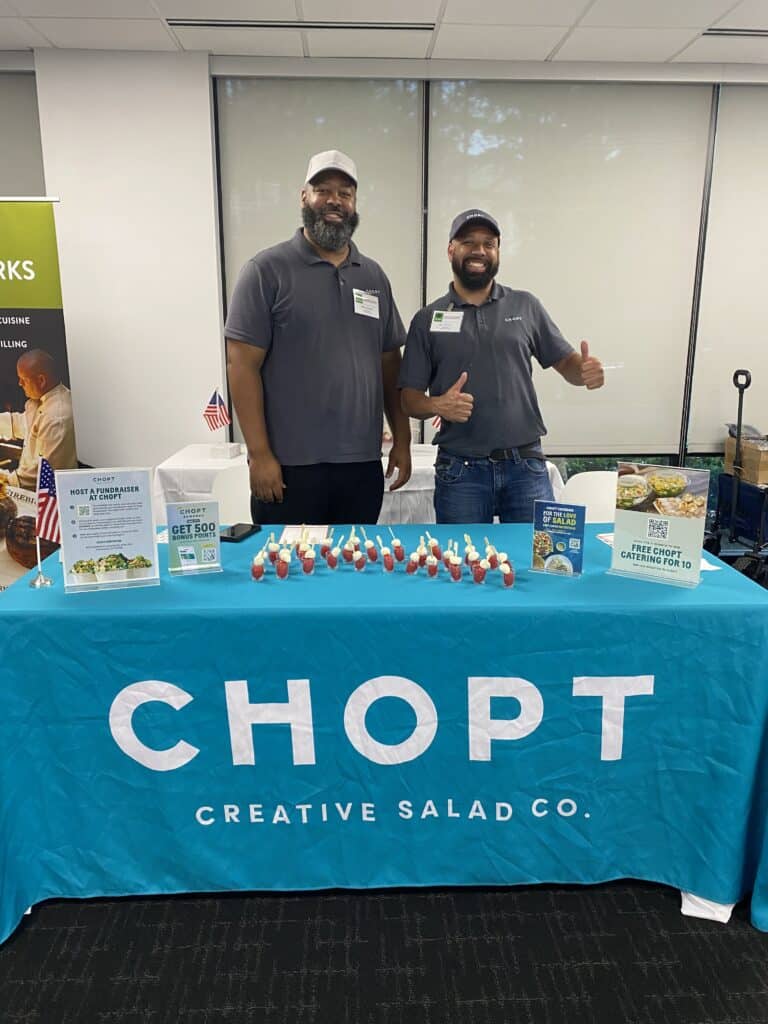

The folks from Marlow’s Tavern were also on-site serving shrimp and grits with jalapeno, spinach and tomato beurre blanc. This is definitely the style of elevated food I’ve come to expect from Marlow’s. And as a nice touch, they prepared a refreshing blueberry cocktail.
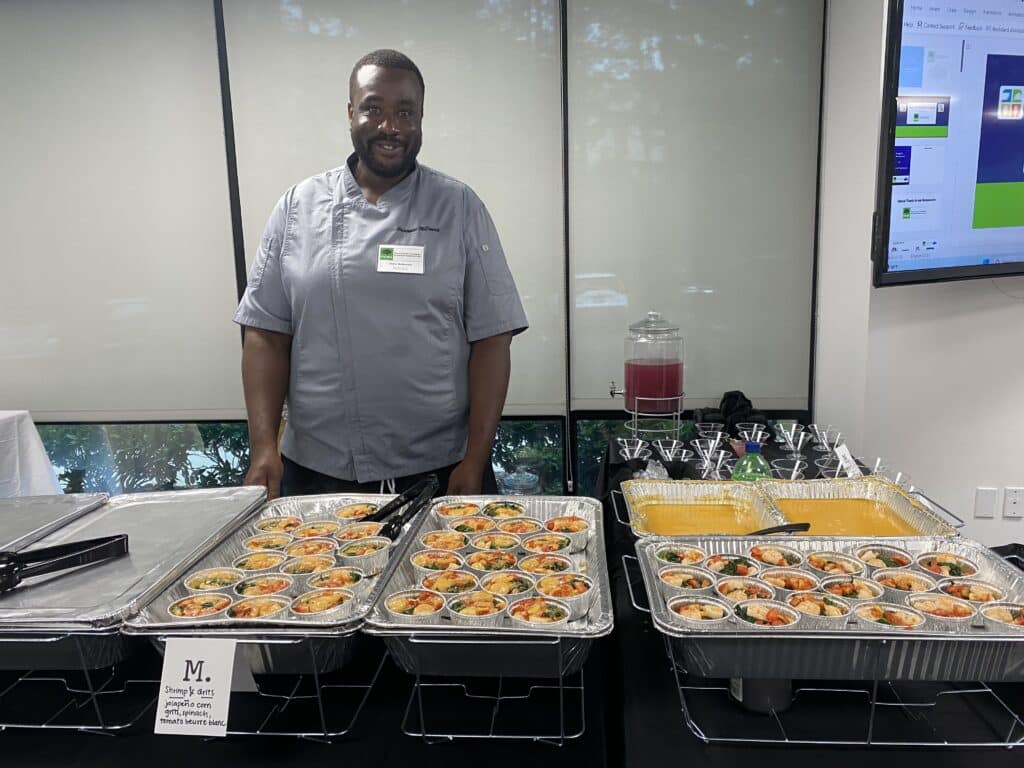

Another familiar face was set up on the other side of the room. J.R.’s Log House Restaurant served southern favorites like pulled pork sliders, baked beans and mac n’ cheese. I couldn’t pass this one up. The pulled pork was tender, tangy and saucy. Exactly what I want from a barbecue. Lazy Dog’s table really impressed me with its presentation. The tuna cup with rice, avocado and chili with chips on the side, was a real stunner.
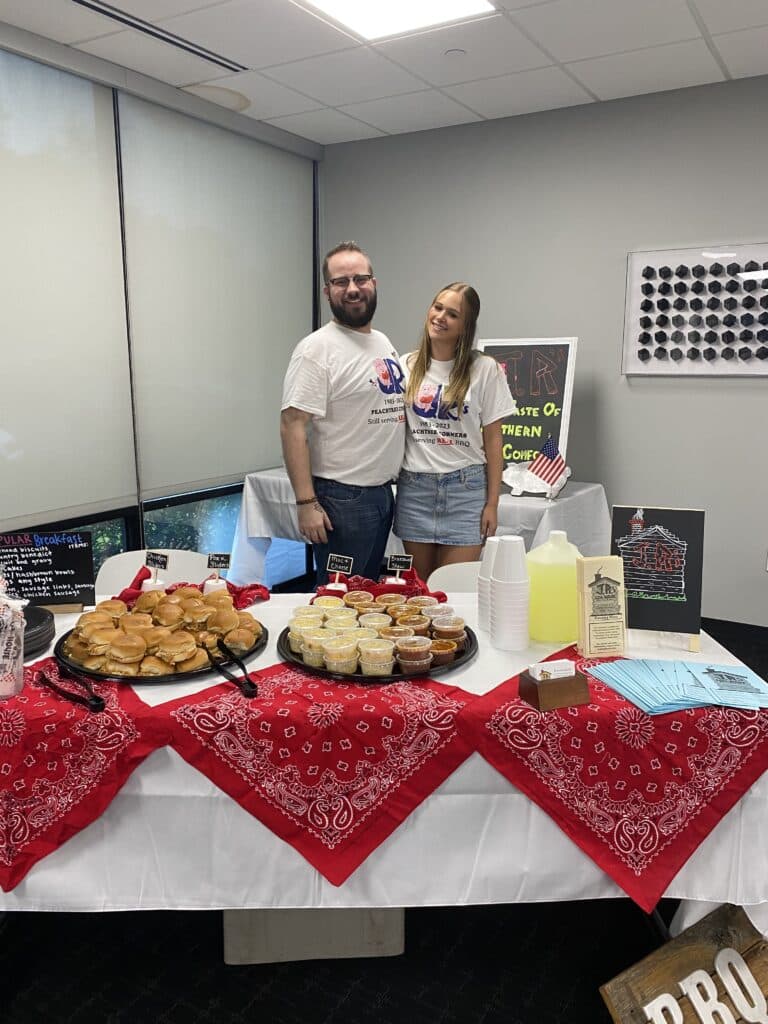
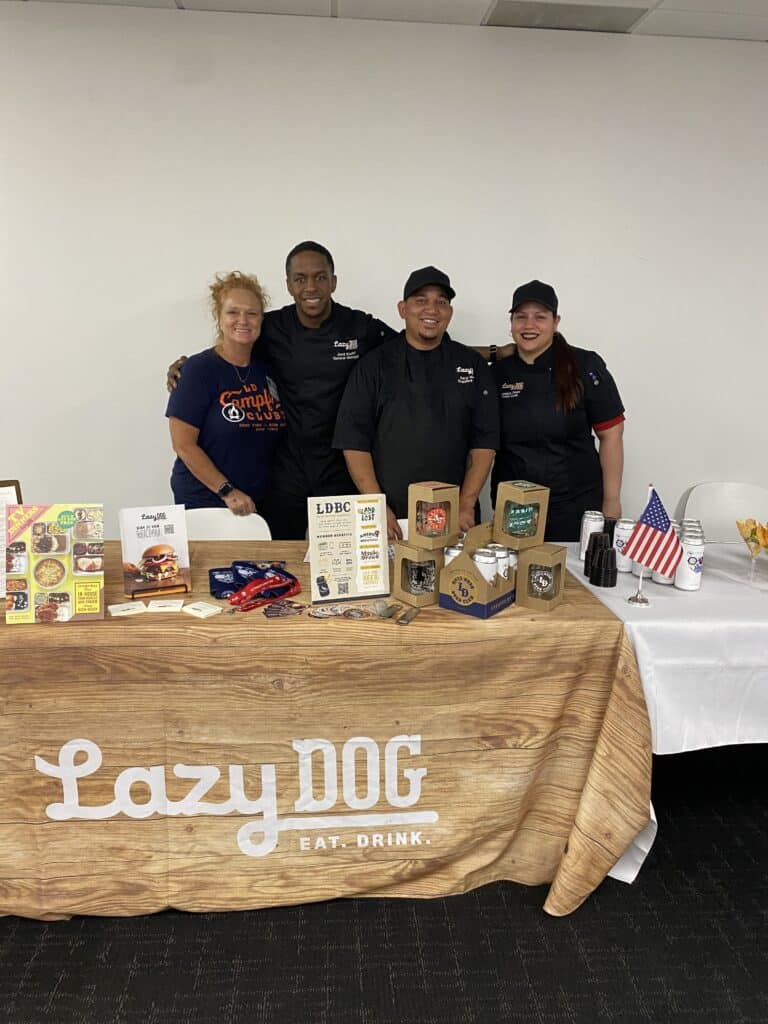
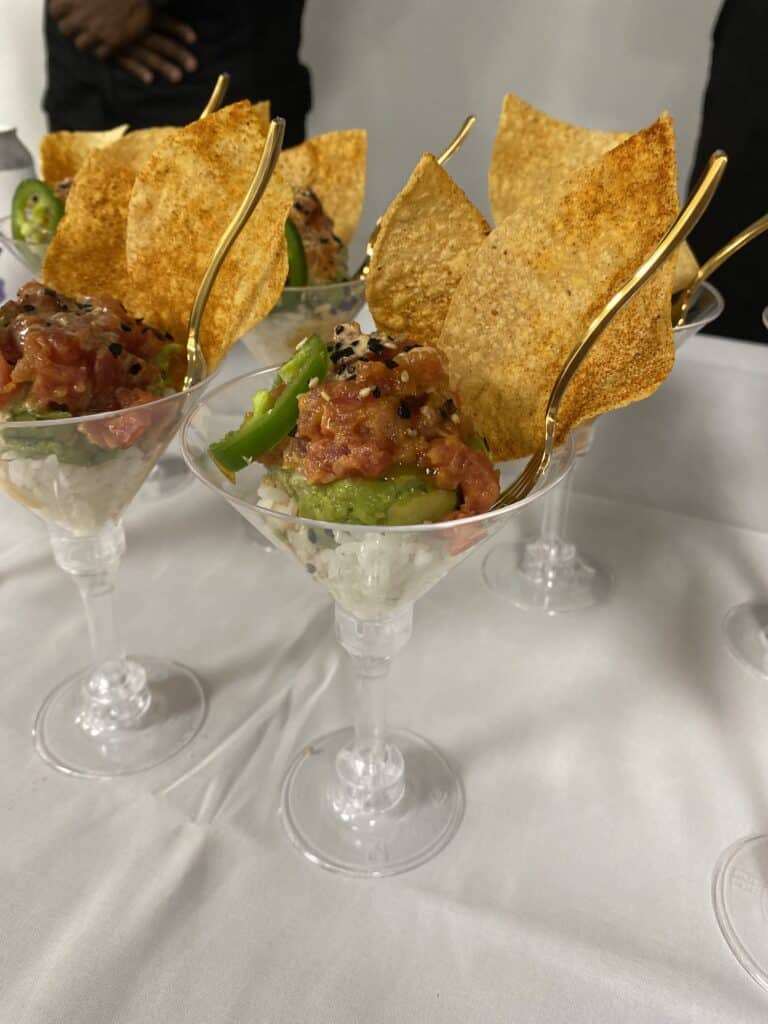
Moe’s Southwest Grill was also on-site handing out tasty tequila lime chicken with rice, avocado, and black beans. This super hearty and comforting entrée was followed by a seafood course from PECHE Modern Coastal. Crab cakes with a croissant pinwheel, roasted garlic and lemon aioli and arugula were on the menu and the flavor combinations were simply fantastic.
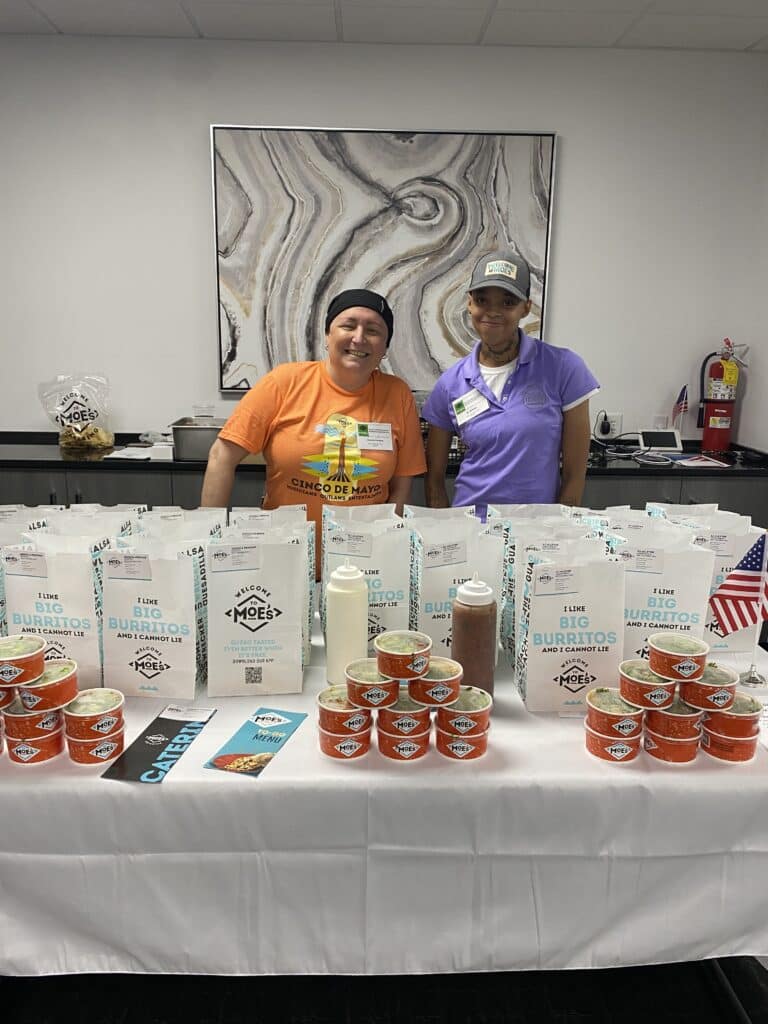
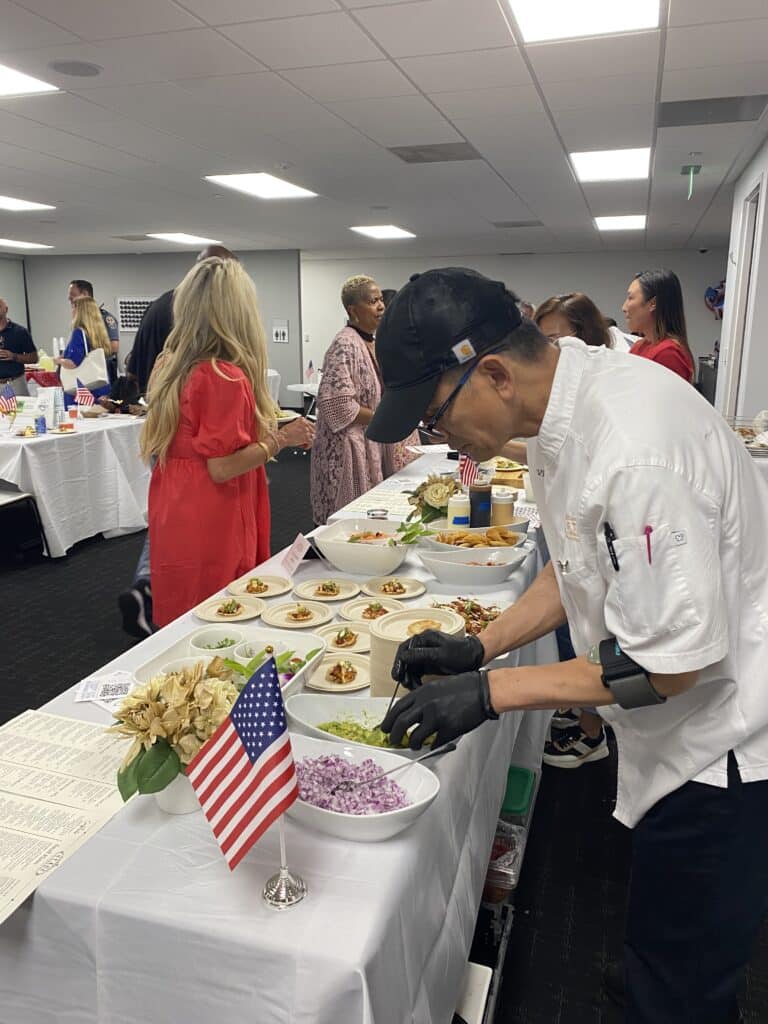
PECHE’s sister restaurant STAGE Kitchen & Bar was next door offering a tuna and salmon tostada with avocado, eel sauce, spicy mayo, and cilantro. This was easily one of my favorite bites of the night. The tostada was crunchy and light with clean and bright flavors. No kidding, I could probably eat this every day for lunch.
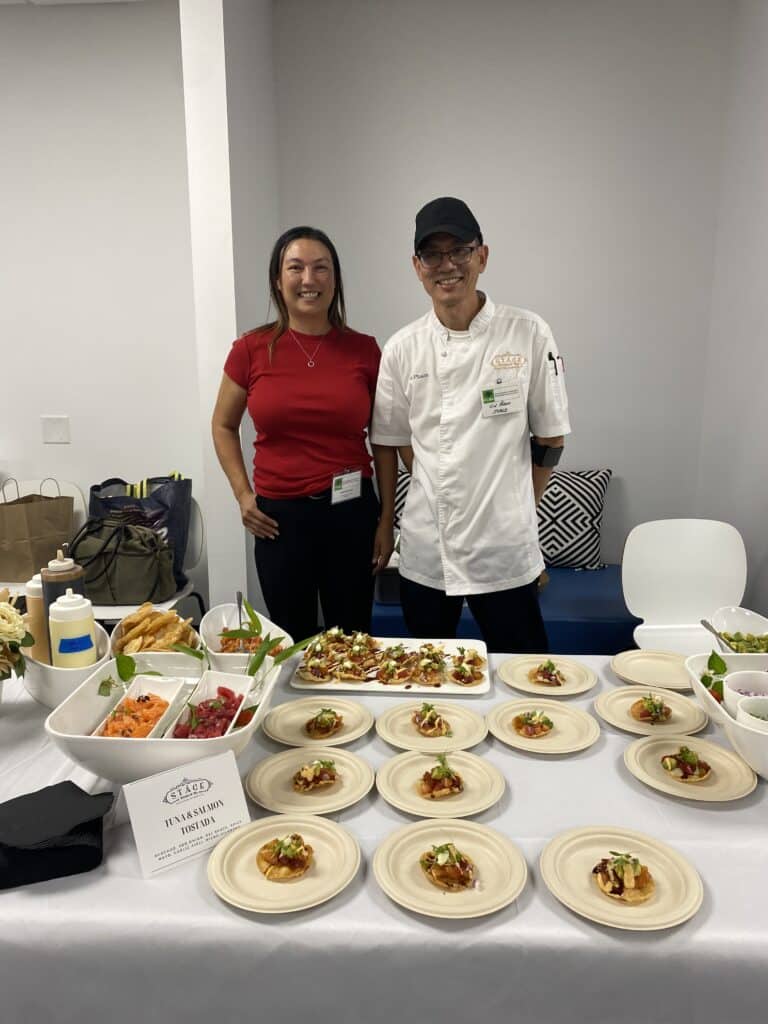

I moved on the Smoke’s Family Catering and owner Phillip Smoke had whipped up enough barbecue to feed an army. I had the pleasure of trying the smoked chicken with potato salad and it was the perfect pairing. Last but not least: dessert. I capped off the evening with a beautiful chocolate ganache-filled croissant with perfect lamination and flaky texture.
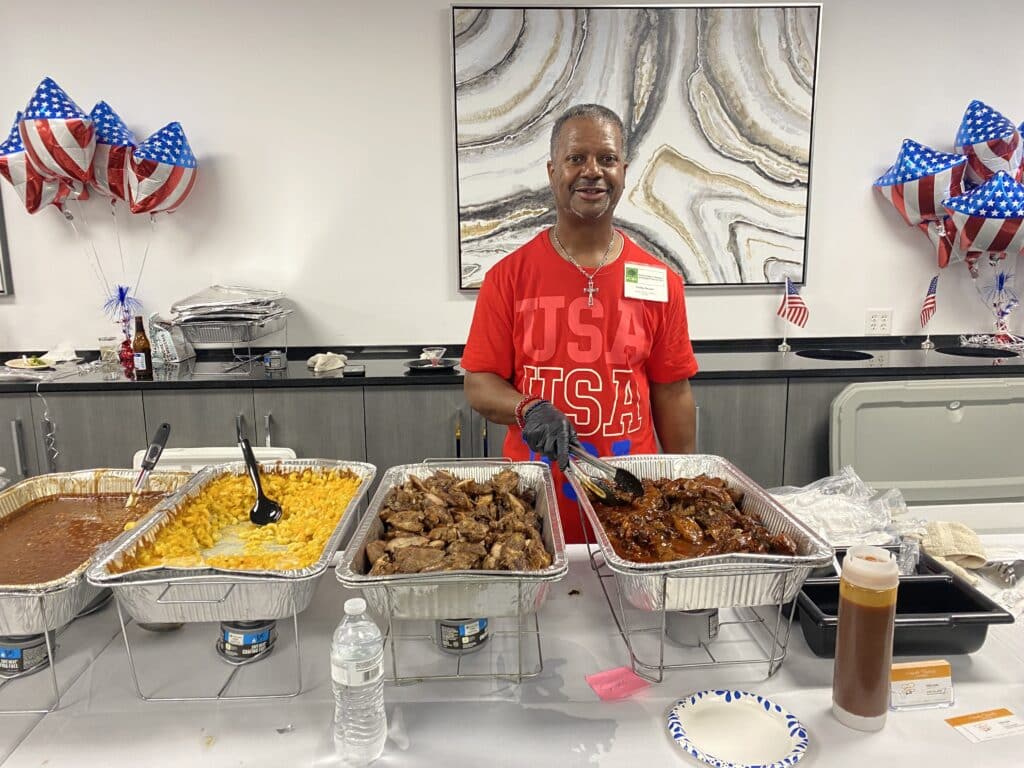
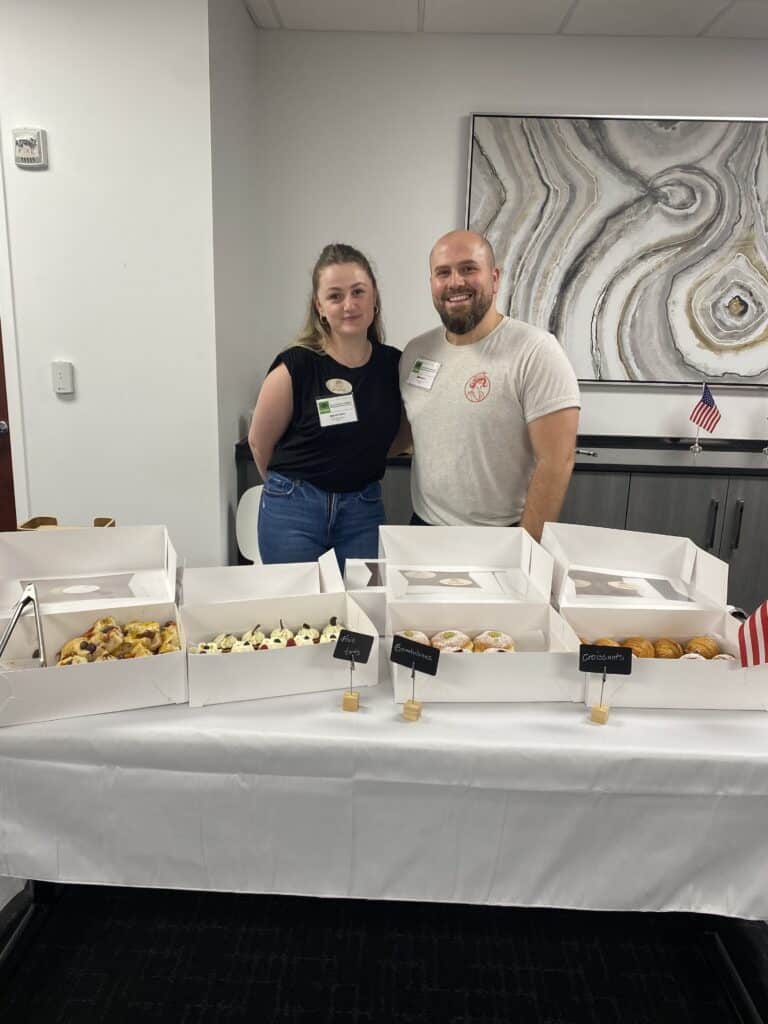

The inspiration behind the event
With a (very) full stomach, I caught up with PCBA President Lisa Proctor to talk about the event.
“We knew that COVID was really hard on a lot of our restaurants to get people back in,” said Proctor. “We wanted to do it in June because we wanted to celebrate our military. Everybody remembers them maybe on Memorial Day or different things, but June is the 80th anniversary of D-Day.”
“The military is always close to our heart,” she added. “We’re also very proud of our restaurants. They all have gone above and beyond.”
Tonight, the PCBA was honoring the Armed Forces and its brave veterans while bestowing two donation checks to very worthy causes.
The first check for $500 went to Folds of Honor. Since 2007, Folds of Honor has provided life-changing scholarships to the spouses and children of America’s fallen or disabled military. And now, their mission expands to the families of America’s first responders.
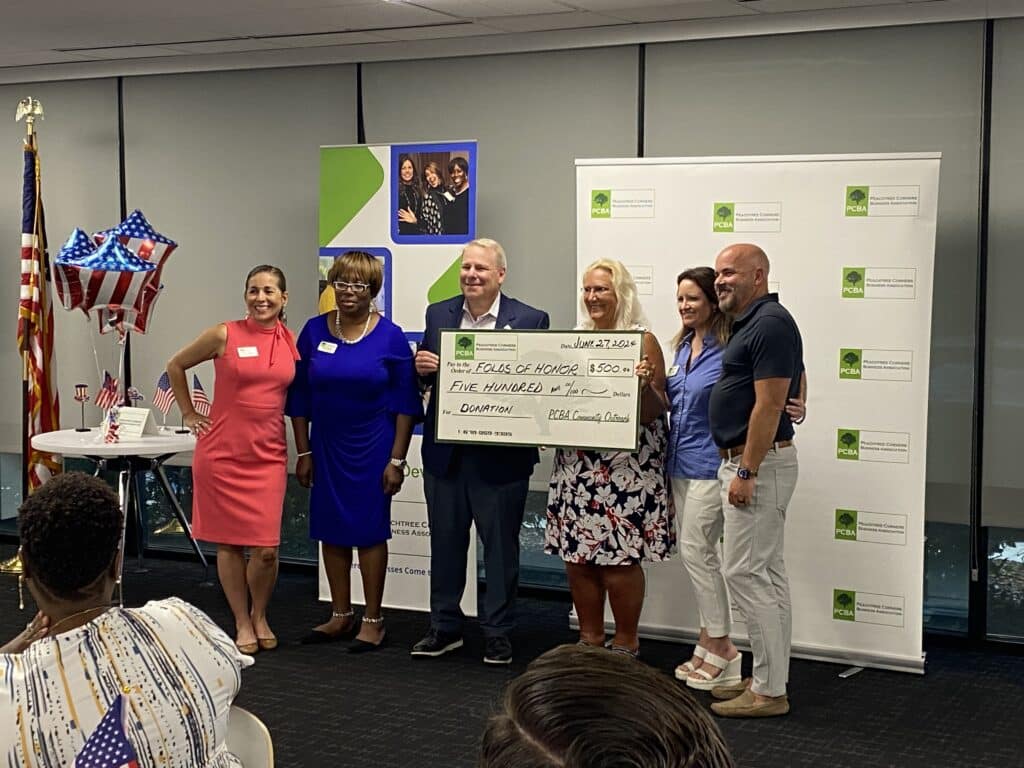
The second check for $500 was given to Light Up the Corners, a 501(c)(3) volunteer organization with an annual glowing, flashing, blinking, shining, nighttime running party and fundraiser in one. All proceeds from the event go to benefit less fortunate children and families in the Peachtree Corners community who are struggling by giving them the chance to participate in life-enhancing programs and activities at the Fowler YMCA.

Over the past 12 years, the PCBA has awarded 19 scholarships and donated more than $156,000+ back to the Peachtree Corners community.
Related
Business
Local Resident Opens AtWork Location in Peachtree Corners
Published
2 weeks agoon
July 10, 2024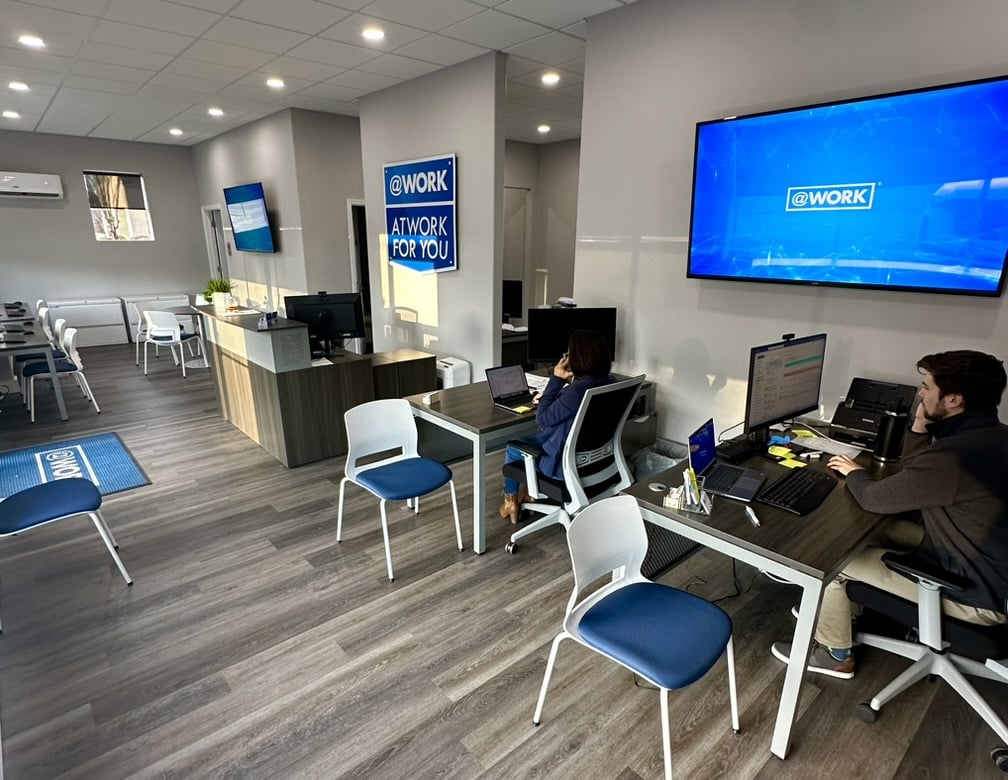
AtWork, one of nation’s leading staffing franchises, has opened its third Metro Atlanta location in Peachtree Corners, Georgia at 6185 Buford Highway, Suite E-100.
AtWork Peachtree Corners is locally-owned by Kamal Bhatia, an immigrant from India with decades of experience in hospitality and as the Senior Vice President of Operations of Atlanta-based Action Bartending School.
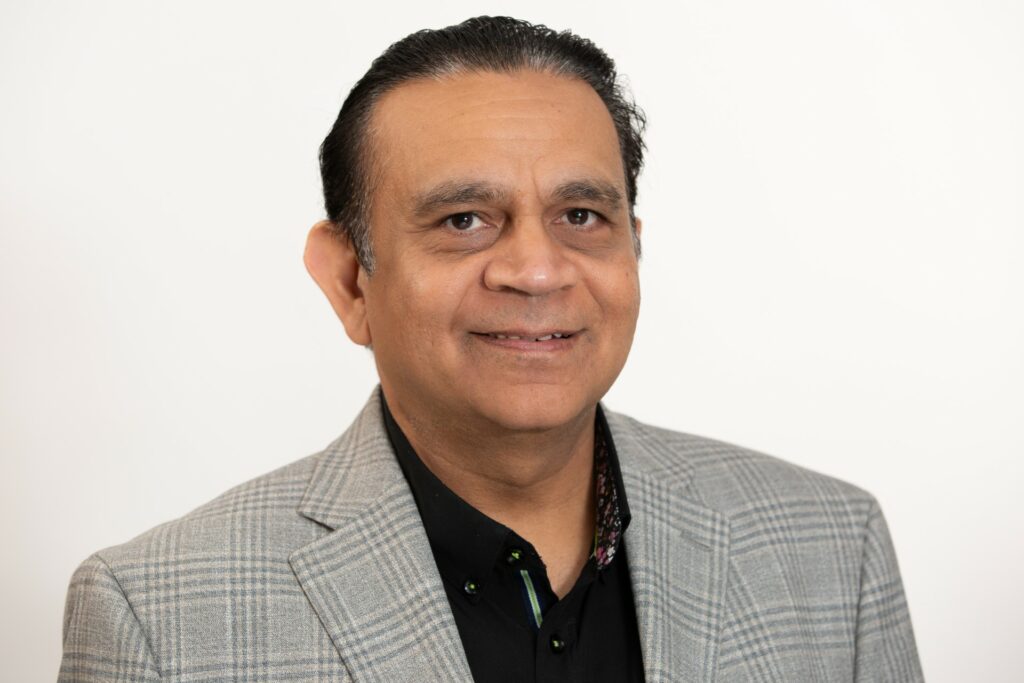
“There is an incredible need for AtWork’s services in Peachtree Corners,” said Bhatia. “Since migrating here in 1996, I’ve witnessed Atlanta evolve and sprout new communities north of the city, including my own. Peachtree Corners has become a hub for thriving businesses, and my goal with this location is to be a key resource between companies and job seekers to support the continued growth of our local economy.”
Bhatia’s son and daughter will assist him in the business.
“This is an opportunity to create a legacy company to ensure our community is supported for generations to come,” he said.
For more than three decades, AtWork’s mission has been to connect people with jobs and jobs with people. With more than 100 locations nationwide, AtWork puts nearly 40,000 individuals to work each year in administrative, light-industrial, accounting and finance, hospitality, IT and management-level positions at some of the nation’s largest and most recognizable companies.

“We’re proud to open our doors in Peachtree Corners and provide a common place for both job seekers and growing businesses to turn for staffing solutions,” said Jason Leverant, President and COO of AtWork.
“AtWork will serve as a key resource to help employees thrive, businesses prosper and communities flourish. Kamal is the perfect partner to champion our mission and be a servant leader in her local community,” he added.
Related
Read the Digital Edition
Subscribe
Keep Up With Peachtree Corners News
Join our mailing list to receive the latest news and updates from our team.
You have Successfully Subscribed!

What’s going on at Jones Bridge Park and the Challenges of Urban Development

Taste of Peachtree Corners: PCBA Showcases Local Restaurants

The Forum Gives Sneak Peek of New Eateries and Community Spaces

Southwest Gwinnett Mayors Share Visions for the Future

8 Events Happening In and Around Peachtree Corners This August

Peachtree Corners Shines Bright with Light Up the Corners Glow Race this August

Peachtree Corners Shines Bright with Light Up the Corners Glow Race this August

The Forum Gives Sneak Peek of New Eateries and Community Spaces

8 Events Happening In and Around Peachtree Corners This August

Southwest Gwinnett Mayors Share Visions for the Future

Taste of Peachtree Corners: PCBA Showcases Local Restaurants

What’s going on at Jones Bridge Park and the Challenges of Urban Development

Local Resident Opens AtWork Location in Peachtree Corners

CHRIS 180 Expands its Services into Gwinnett County [Podcast]

Light up the Corners [Video]

Capitalist Sage: Business Leadership in Your Community [Podcast]

Cliff Bramble: A Culinary Adventure through Italy

Top 10 Brunch Places in Gwinnett County

A Hunger for Hospitality

THE CORNERS EPISODE 3 – BLAXICAN PART 1

Top 10 Indoor Things To Do This Winter

The ED Hour: What it takes to Remove Barriers from Education
Peachtree Corners Life
Topics and Categories
Trending
-
Business1 week ago
Taste of Peachtree Corners: PCBA Showcases Local Restaurants
-
Business2 days ago
The Forum Gives Sneak Peek of New Eateries and Community Spaces
-
City Government4 days ago
Southwest Gwinnett Mayors Share Visions for the Future
-
Around Atlanta4 days ago
8 Events Happening In and Around Peachtree Corners This August


